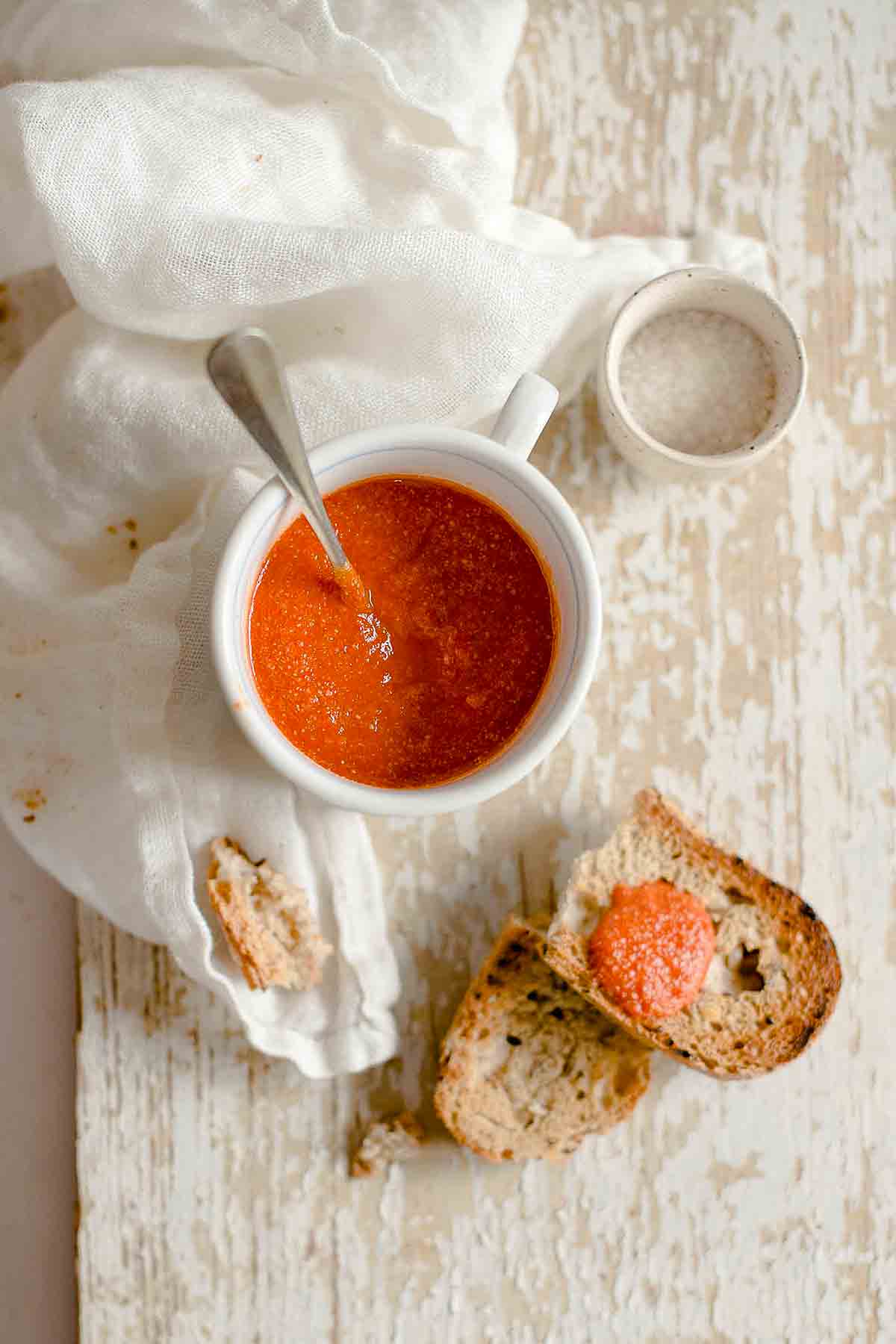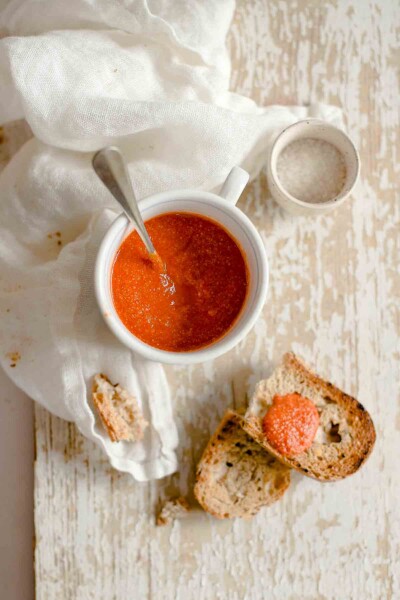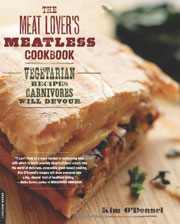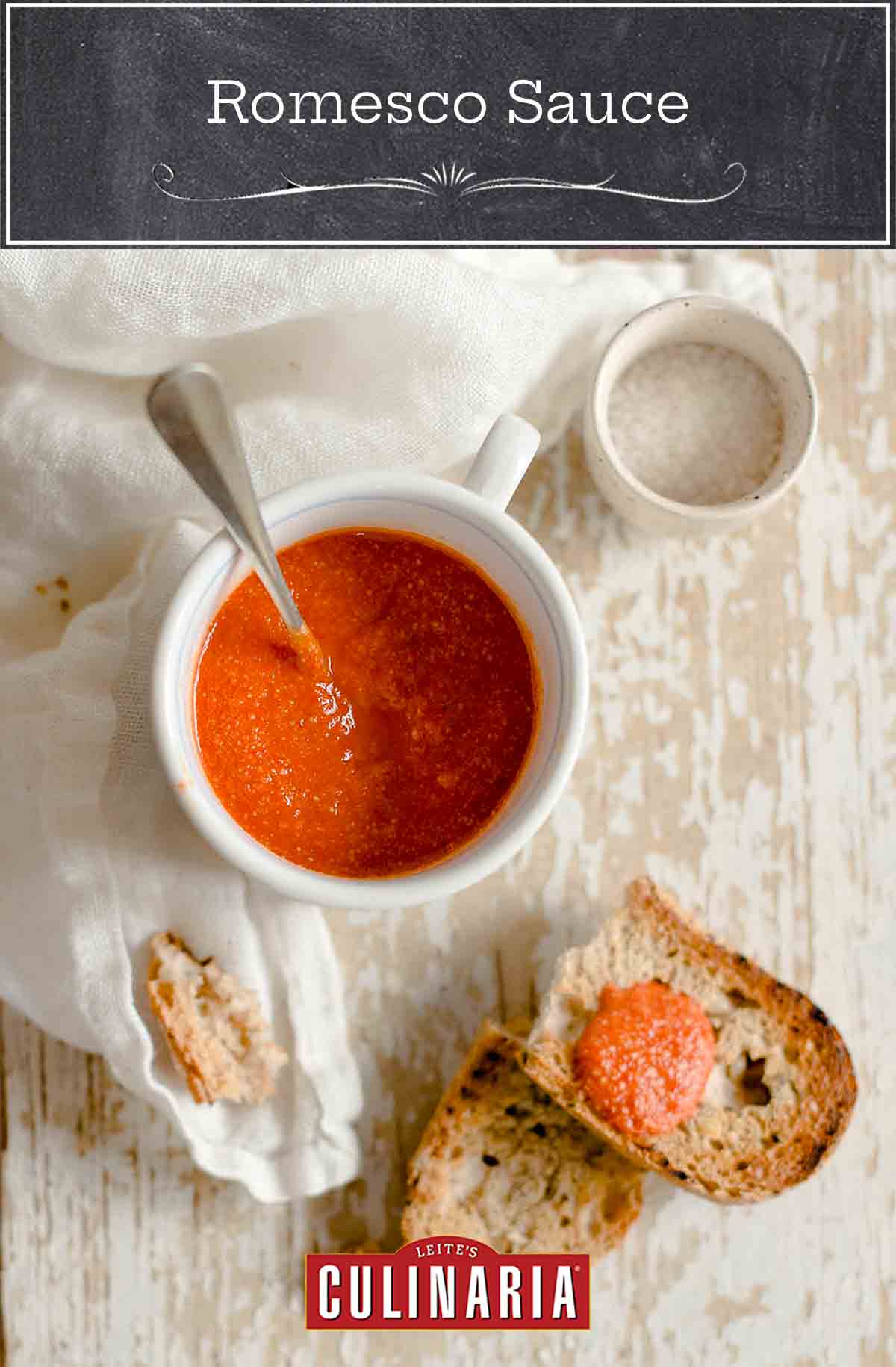
Romesco sauce is simply an almond, garlic, and roasted pepper-scented puree that hails from Catalan, in the northeastern part of Spain along the Mediterranean coast. It’s a classic. [Editor’s Note: A vegan classic.] You can spread it on grilled bread, use it as a dip for roasted or grilled broccoli, or eat it right from the spoon.–Kim O’Donnel
Author’s Pick a Peppa’ Note
Ancho chiles are dried poblanos, which will yield a sweeter, almost raisin-y Romesca sauce; fresh roasted poblanos will deliver more smoke. Don’t worry if you don’t have all the peppers listed in the ingredients below. If red bell peppers are all you have, this elixir, er sauce, will still make you swoon.
Want to Save This?

Romesco Sauce
Ingredients
- A 1-pound loaf country-style bread
- 1/4 cup olive oil
- 2 red bell peppers, roasted, peeled, and seeded
- 3 dried ancho chile peppers, soaked for 1 hour, drained, seeded, and roughly chopped, or 2 fresh poblano chile peppers, roasted, peeled, and seeded (either pepper is optional, but makes a really nice addition to the resulting sauce)
- 1/2- to 1-inch piece fresh serrano or jalapeño pepper, seeded and minced
- 4 cloves garlic, minced
- 1/2 cup almonds and/or hazelnuts, roasted
- 2 to 3 plum tomatoes, peeled and seeded (I use canned whole plum tomatoes, drained)
- 2 teaspoons red wine vinegar or lemon juice
- 1/2 teaspoon salt
- 1/4 teaspoon cayenne
- 1/4 teaspoon smoked paprika, (this, too, is optional, although it’s particularly useful in the absence of the optional ancho or poblano chile peppers)
Instructions
- In a skillet over medium heat, heat 1 tablespoon oil. Cut a 1-inch-thick slice from the loaf of bread, trim the crusts from the slice, and toss it in the skillet. Let it sizzle until golden on both sides, about 5 minutes total. Transfer to a plate and let cool. Set the rest of the loaf aside.
- In a food processor, pulse all of the bell and chile and hot peppers along with the garlic, nuts, and the fried bread slice. Pulse until combined but still chunky.
- Add the tomatoes and pulse to combine. Then add the remaining oil and vinegar and pulse. The mixture will emulsify quickly. Add the salt, cayenne, and smoked paprika, if using. The romesco sauce should be thick but also have a slightly viscous quality. If it seems on the thick side, add 1 to 2 tablespoons of water. Taste for salt and heat and acid and season accordingly. You can cover and refrigerate the romesco for up to 5 days. It just gets better and better with every day the flavors are allowed to meld.
- Slice the remaining loaf of bread, allowing 1 to 2 pieces per person, and grill or toast until lightly browned. Serve with the romesco.

Explore More with AI
Nutrition
Nutrition information is automatically calculated, so should only be used as an approximation.
Recipe Testers’ Reviews
This smoky, spicy and garlicky sauce was fantastic with every item on our dinner plates: we smothered it on lamb chops, put dollops on roasted potatoes, and dipped grilled asparagus in it. Yes, there are quite a few ingredients, and there’s a lot of prep work involved for just two cups of sauce, but I did some online research and have good news for us all: romesco sauce keeps well in the freezer, for up to three months. Make a lot, and divvy it up for later use; it’s worth the trouble. In my own romesco, I used ancho chile peppers, a jalapeño pepper, hazelnuts, and smoked paprika.
Don’t ask any questions, just double the recipe! Oh, and have extra bread and spoons on-hand. This “elixir” is pure heaven—not only good as a dip, a spread, and straight from the spoon, but it’s wonderful on grilled fish or chicken, isn’t too bad on pasta, and you can even add a few spoonfuls to a pot of soup (your guests will wonder what the secret ingredient is). I feel that canned tomatoes work better than fresh, simply because of the uniformity you get with canned. Make the romesco a little thick to begin with; you can always thin it later if necessary. When working with hot peppers, garlic and paprika, I like to follow the recipe exactly at first to get an idea of the level of spice or heat. I’d suggest using the jalapeño with the cayenne, unless you like more heat. The red wine vinegar is better with the smoky sweetness of the peppers.
This sauce is rich and warming, with a great level of spice and flavor. It definitely improves over time, too. I thinned the sauce with water until it had a pourable consistency, and tossed it with some vegetables before roasting them in the oven. I used hazelnuts this time, and look forward to mixing in some almonds next time. I’ll definitely make this again.
This is a delicious sauce, and is very easy to make. There were a few issues with the recipe which can be easily remedied for next time: First, the skins of my dried chile peppers didn’t break down very well in the food processor. Next time, I’ll either scrape the reconstituted pulp from the skins and discard the skins (as I was taught by a Catalan chef this past summer), or I’ll process the reconstituted peppers first to break them down, and then add the rest of the peppers to the processor. Also, four cloves of raw garlic make for a very garlicky sauce with a strong, lingering aftertaste. I think the sauce would be much better with less garlic, probably half of the amount specified. The sauce definitely gets better with time; aging it for few days did allow the vinegar and other ingredients to meld. For me, the vinegar taste was a bit too pronounced right after the sauce was made. I peeled and seeded the fresh plum tomatoes using the concasse method. Certainly, canned whole plum tomatoes (ideally San Marzano) would work fine. If using fresh tomatoes, an easier alternative is to simply grate the tomatoes with their skins on a box grater.
I don’t know why it took me so long to make this amazing sauce at home. I’ve run into it in various guises at many restaurants, and even looked up the recipe a few times, but never grabbed the ingredients to make it. What’s funny is that all of its ingredients are staples in my house. I have a pepper plant that’s just giving up its last fruits, both types of nuts in the freezer (I used half almonds/half hazelnuts), canned tomatoes, and jars of roasted bell peppers in the cupboard, and whole, dried anchos in my spice collection. I did have to adjust the vinegar to about twice the amount called for and still needed to add some extra water to make it sauce-like. But the resulting romesco was a complete joy smeared on some toast with a fried egg the morning after. This is definitely a repeat item.
It’s funny that this recipe comes from a vegetarian cookbook, because this is hands down the best side I’ve ever had with steak. All the roasting, peeling, and seeding is totally worth it, as the end result is bursting with complex, smoky flavors. I would suggest using a little less bread than the recipe calls for, as my sauce came out a little too thick. This recipe makes a lot! I halved the recipe and got about 1 3/4 cups.
Amazing! What an ingenious combination of humble pantry staples. I had not made Romesco in years, and i was delighted to have stumbled upon this recipe. I used hazelnuts instead of almonds and 2 Thai peppers instead of jalepeno. I quite liked the little bit of heat they added to the sauce. I served it on day 1 with pasta, day 2 with baked chicken, and day 3 to flavor paneer tikkas as an appetizer. You will enjoy the versatility of this sauce as it lends itself beautifully to fusion cuisines. It works well with veggies, meats, eggs—in short, its uses are limited only by your imagination. This will be a staple in our home.














On a recent version, I mixed almonds and pistachios. I also used white vinegar and really good sherry to lift the acidity. I have to say, it was quite good despite being slightly out of its lane.
Richard, out of its lane but certainly a detour worth making. I shall try it soon.
So good, great result for the first time to make it. It would have been a great result if it were my umpteenth time to make it! Yes, double (or more) the recipe, eat it from the spoon, swoon. Now that I think about it, what would it not be good served with.
Excellent news, Susan! So glad that you like the recipe. And, yes, spooning is always an option.
Late to the party, but I’m wondering if any paprika pepper can be used if the ñoras aren’t available. Anyone know?
Never too late to ask a question, ruthie. You’re referring to the smoked paprika powder, yes? Not the whole chiles? IF so, yes, any paprika will do.
Nope. The actual peppers. I usually grow two or three varieties of paprika peppers ’cause I love the stuff. 😉 I don’t think I’ve seen the ñoras, though, when I was looking for plants or seeds. So, I’m wondering if i could use another paprika pepper, as long as it’s not a hot one.
I make something very similar to this with just roasted red bells, but this sounds so much tastier!
Ah. I bet it’d be lovelier with your paprikas, ruthie. The recipe offers red bell peppers as an option, but yes, your paprikas will offer far more nuance and complexity, me thinks.